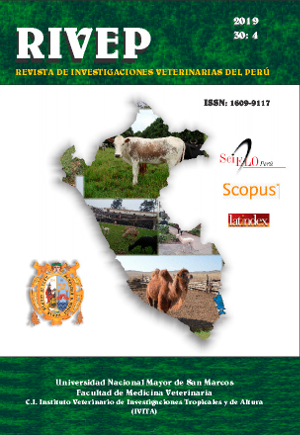Phenotypic variations of the textile characteristics of pre-dehaired fibre of vicuña
DOI:
https://doi.org/10.15381/rivep.v30i4.17265Keywords:
vicuña, fine fibre, fibre length, fibre diameter profileAbstract
The aim of this study was to evaluate the effect of the age and sex of the vicuña on the mean fibre diameter (MFD), spinning fineness, curvature index, fibre length and fibre diameter profile; also, to calculate the phenotypic correlations between fibre textile characteristics. Pre-dehaired samples (n=88) were analysed with the OFDA 2000 equipment. In the statistical model the age, sex and age:sex interaction were considered as fixed effects. Sex had a significant effect on the phenotypic variations of DMF, maximum and minimum diameter profile; likewise, age had a significant effect on MFD, spinning fineness and minimum profile diameter. However, the interaction of sex and age had no effect on the characteristics studied. The phenotypic correlations were significant and positive between DMF and spinning fineness, spin fineness and standard diameter deviation, standard deviation and coefficient of variation of diameter, standard deviation of diameter and diameter difference in fibre profile. Phenotypic correlations were negative: percentage of fibres <30 µm with standard deviation of fibre diameter, fibre diameter coefficient of variation and spinning fineness. In addition, there is phenotypic variability of MFD and fibre diameter profile in adult and young vicuñas. Age, sex and pre-dehairing affected some fibre characteristics related to the fineness and comfort of the fibre.
Downloads
Downloads
Published
Issue
Section
License
AUTHORS RETAIN THEIR RIGHTS:
a. Authors retain their trade mark rights and patent, and also on any process or procedure described in the article.
b. Authors retain their right to share, copy, distribute, perform and publicly communicate their article (eg, to place their article in an institutional repository or publish it in a book), with an acknowledgment of its initial publication in the Revista de Investigaciones Veterinarias del Perú (RIVEP).
c. Authors retain theirs right to make a subsequent publication of their work, to use the article or any part thereof (eg a compilation of his papers, lecture notes, thesis, or a book), always indicating the source of publication (the originator of the work, journal, volume, number and date).










